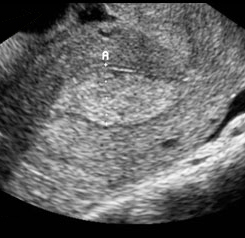by
Astrid Fiano, DOTmed News Writer | May 06, 2009
Researchers at UT Southwestern Medical Center, in Dallas, TX, have found that a procedure in conjunction with a vaginal ultrasound might assist in visualizing and diagnosing diseases in the uterus lining. The study is available online and in the April issue of Obstetrics and Gynecology. The study demonstrates that using saline-infusion sonography (SIS) or ultrasound enables doctors to see where exactly in the endoetrium a polyp/growth is located, and to biopsy it accordingly.
According to a UT press release, in the research, physicians evaluated the endometrium, a cavity that lines the inside of the uterus, of women in or past menopause and complaining of abnormal bleeding. Abnormal bleeding may indicate certain diseases of the endometrium, possibly malignant. Currently, the procedure is to blindly biopsy the endometrium; however, the biopsy might not include the part of the cavity that is diseased.
On a sonogram, water appears dark and tissue is light, therefore polyps or tumors are brighter in comparison with the surrounding saline solution. The SIS procedure involves physicians injecting saline through a catheter threaded into the uterus through the cervix to fill up and expand the endometrial cavity. Any existing growth can then be easily visualized and biopsied under sono guidance and then sent to a pathologist for analysis.



Ad Statistics
Times Displayed: 174531
Times Visited: 3184 For those who need to move fast and expand clinical capabilities -- and would love new equipment -- the uCT 550 Advance offers a new fully configured 80-slice CT in up to 2 weeks with routine maintenance and parts and Software Upgrades for Life™ included.
"Saline infusion sonography augments the usual transvaginal sonogram and lets us see what is inside the endometrium," the press release quoted Dr. Elysia Moschos, associate professor of obstetrics and gynecology at UT Southwestern and the lead author of the study. "Normally, the endometrial cavity is collapsed, but when we infuse it with saline, we can visualize inside the cavity and see if it contains any abnormalities."
In the research, a total of 88 saline-infusion sonography endometrial samples were obtained. According to the press release, in the final outcome of 80 of those samples, saline-infusion endometrial sampling provided a diagnosis 89 percent of the time, compared to 52 percent for standard endometrial biopsy.
From the results of the study, it appears that there would be no women for whom blind biopsy of the endometrium would still be an appropriate first step, Dr. Moschos said. In this study, blind biopsies missed 15 of 16 benign polyps and one-third of cancers. However, the saline-infusion sonography endometrial sampling correctly diagnosed two-thirds of benign polyps and no premalignant or malignant growths were missed by this method.
Dr. Moschos explained in the press release that abnormal bleeding is a common complaint among patients, particularly during and after menopause. If this symptom occurs, it needs to be evaluated for any kind of gynecologic cancers, with the first step of imaging the endometrium by ultrasound. In addition, the release notes the American College of Obstetrics and Gynecology says postmenopausal women with an endometrial lining thicker than 4 millimeters need further follow-up.
"In women with abnormal endometrial appearances, SIS should then be performed. If the endometrium is uniformly thickened on the SIS exam, only then is a blind biopsy appropriate," Dr. Moschos said. "However, most endometrial pathology is focal, and therefore directed sampling, such as with saline infusion sonography guidance, is necessary."
Based on a press release by UT Southwestern

